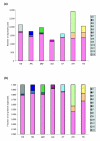The gain and loss of genes during 600 million years of vertebrate evolution
- PMID: 16723033
- PMCID: PMC1779523
- DOI: 10.1186/gb-2006-7-5-r43
The gain and loss of genes during 600 million years of vertebrate evolution
Abstract
Background: Gene duplication is assumed to have played a crucial role in the evolution of vertebrate organisms. Apart from a continuous mode of duplication, two or three whole genome duplication events have been proposed during the evolution of vertebrates, one or two at the dawn of vertebrate evolution, and an additional one in the fish lineage, not shared with land vertebrates. Here, we have studied gene gain and loss in seven different vertebrate genomes, spanning an evolutionary period of about 600 million years.
Results: We show that: first, the majority of duplicated genes in extant vertebrate genomes are ancient and were created at times that coincide with proposed whole genome duplication events; second, there exist significant differences in gene retention for different functional categories of genes between fishes and land vertebrates; third, there seems to be a considerable bias in gene retention of regulatory genes towards the mode of gene duplication (whole genome duplication events compared to smaller-scale events), which is in accordance with the so-called gene balance hypothesis; and fourth, that ancient duplicates that have survived for many hundreds of millions of years can still be lost.
Conclusion: Based on phylogenetic analyses, we show that both the mode of duplication and the functional class the duplicated genes belong to have been of major importance for the evolution of the vertebrates. In particular, we provide evidence that massive gene duplication (probably as a consequence of entire genome duplications) at the dawn of vertebrate evolution might have been particularly important for the evolution of complex vertebrates.
Figures




References
-
- Ohno S. Evolution by Gene Duplication. New York: Springer-Verlag; 1970.
-
- Holland PW, Garcia-Fernandez J, Williams NA, Sidow A. Gene duplications and the origins of vertebrate development. Dev Suppl. pp. 125–133. - PubMed
-
- Garcia-Fernandez J, Holland PW. Amphioxus Hox genes: insights into evolution and development. Int J Dev Biol. 1996;(Suppl 1):71S–72S. - PubMed
Publication types
MeSH terms
LinkOut - more resources
Full Text Sources

